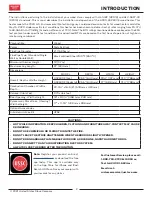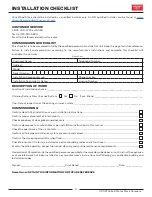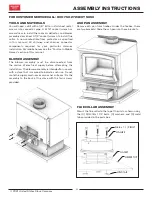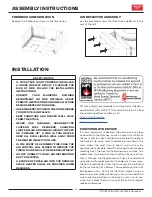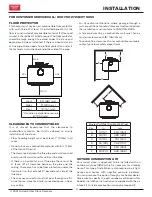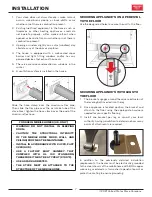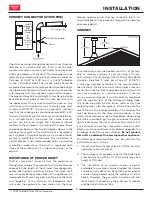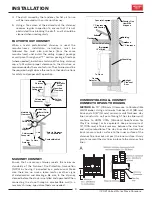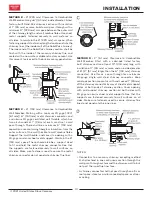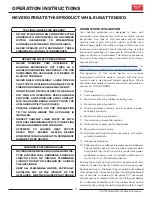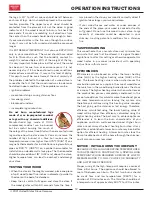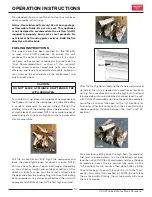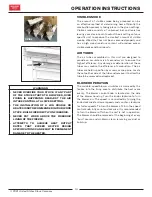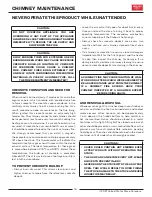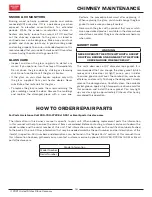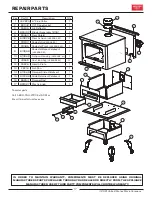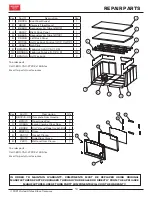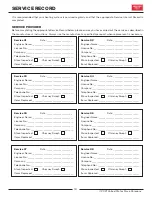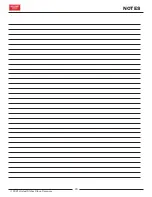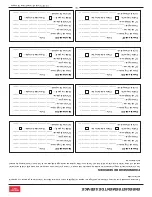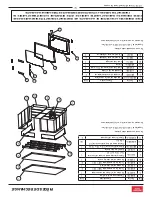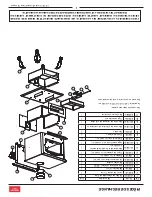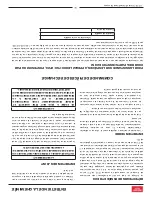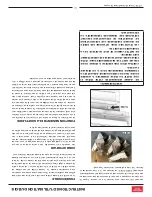
the logs. A 24” to 48” air space should be left between
each row of logs, which should be placed in the sunniest
location possible. The upper layer of wood should be
protected from the element but not the sides. A good
indicator of if the wood is ready to burn is to check the
piece ends. If cracks are radiating in all directions from
the center then the wood should be dry enough to burn.
If your wood sizzles in the fire, even though the surface
is dry, it may not be fully cured and should be seasoned
longer.
It is EXTREMELY IMPORTANT that you use DRY WOOD
only in your wood stove. The wood should have dried
for 9 to 15 months, such that the humidity content (in
weight) is reduced below 20% of the weight of the log.
It is very important to keep in mind that even if the wood
has been cut for one, two, or even more years, it is not
necessarily dry, if it has been stored in poor conditions.
Under extreme conditions, it may rot instead of drying.
This point cannot be overstressed; the vast majority of
the problems related to the operation of a wood stove is
caused by the fact that the wood used was too damp or
had dried in poor conditions. These problems can be:
• ignition problems
• creosote build-up causing chimney fires
• low energy yield
• blackened windows
• incomplete log combustion
Do not burn manufactured logs
made of wax impregnated sawdust
or logs with any chemical additives.
Manufactured logs made of 100%
compressed sawdust can be burned,
but be careful burning too much of
these logs at the same time. Start with one manufactured
log and see how the stove reacts. You can increase the
number of logs burned at a time but make sure the
temperature never rises higher than 475 °F (246 °C) on a
magnetic thermometer for installation on single wall stove
pipes or 900 °F (482 °C) on a probe thermometer for
installation on double wall stove pipe. The thermometer
should be placed about 18” (457 mm) above the stove.
Higher temperatures can lead to overheat and damage
your stove.
TESTING YOUR WOOD
• When the stove is thoroughly warmed, place one piece
of split wood (about five inches in diameter) parallel to
the door on the bed of red embers.
• Keep the air control fully open and close the door. If
the wood ignites within 90 seconds from the time it
was placed in the stove, your wood is correctly dried. If
ignition takes longer, your wood is damp.
• If your wood hisses and water or vapor escapes at
the ends of the piece, your wood is soaked or freshly
cut (green). Do not use this wood in your stove. Large
amounts of creosote could be deposited in your
chimney, creating potential conditions for a chimney
fire.
TAMPER WARNING
This wood heater has a manufacturer-set minimum low
burn rate that must not be altered. It is against federal
regulations to alter this setting or otherwise operate this
wood heater in a manner inconsistent with operating
instructions in this manual.
EFFICIENCIES
Efficiencies can be based on either the lower heating
value (LHV) or the higher heating value (HHV) of the
fuel. The lower heating value is when water leaves the
combustion process as a vapor, in the case of woodstoves
the moisture in the wood being burned leaves the stove
as a vapor. The higher heating value is when water leaves
the combustion process completely condensed. In the
case of woodstoves this would assume the exhaust gases
are room temperature when leaving the system, and
therefore calculations using this heating value consider
the heat going up the chimney as lost energy. Therefore,
efficiency calculated using the lower heating value of
wood will be higher than efficiency calculated using the
higher heating value. The best way to achieve optimum
efficiencies is to learn the burn characteristic of you
appliance and burn well-seasoned wood. Higher burn
rates are not always the best heating burn rates; after a
good fire is established a lower burn rate may be a better
option for efficient heating. A lower burn rate slows the
flow of usable heat out of the home through the chimney,
and it also consumes less wood.
NOTICE - INITIAL BURNS TO CURE PAINT
BECAUSE OF THE HIGH OPERATING TEMPERATURES,
THIS APPLIANCE IS COATED WITH A SPECIAL HIGH
TEMP PAINT WHICH REQUIRES A SERIES OF LOW TO
MEDIUM BURNS TO FULLY CURE FOR DURABILITY
AND A LIFETIME OF SERVICE.
Proper curing of the high-temp paint requires a series of
three initial burns. The appliance should be allowed to
cool off between each burn. The first two burns should
be small fires and low temperatures (250°F) for a
duration of 20 minutes each. The third fire should be at
a temperature of approximately 500°F for 20 minutes.
OPERATION INSTRUCTIONS
12
© 2021 United States Stove Company
Содержание US2500E-P
Страница 20: ...NOTES 20 2021 United States Stove Company ...
Страница 21: ...NOTES 2021 United States Stove Company 21 ...


